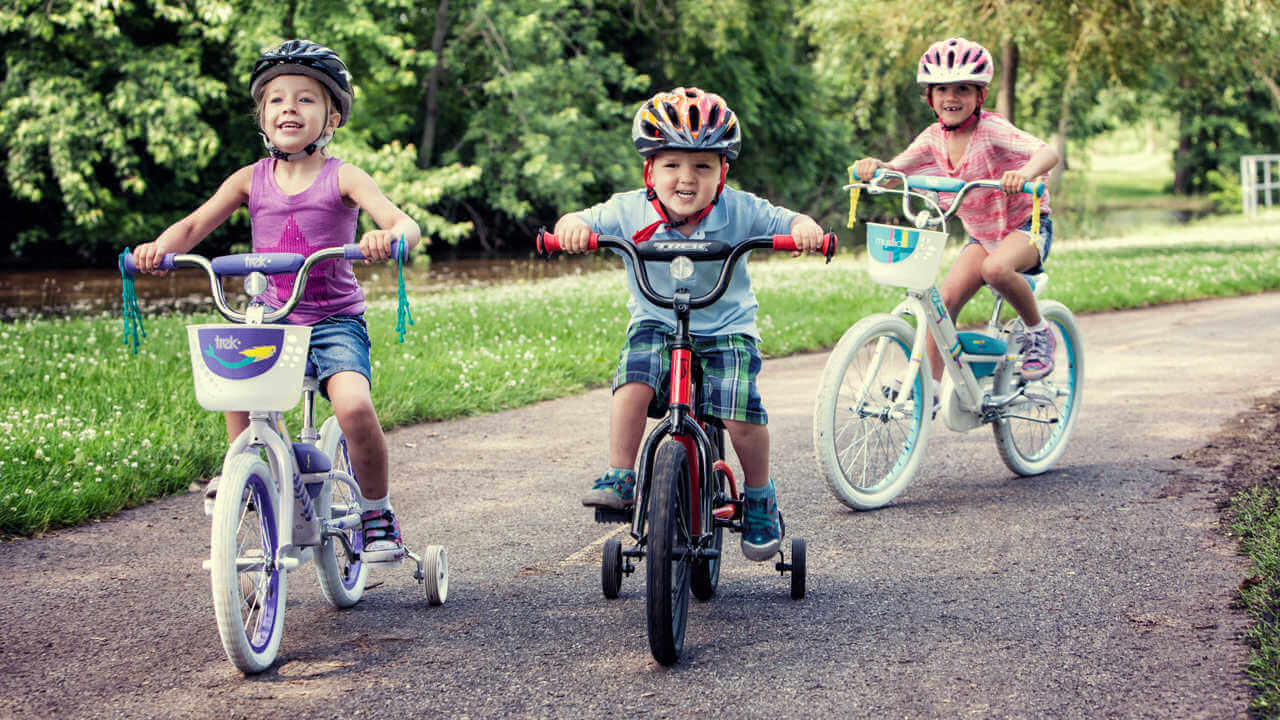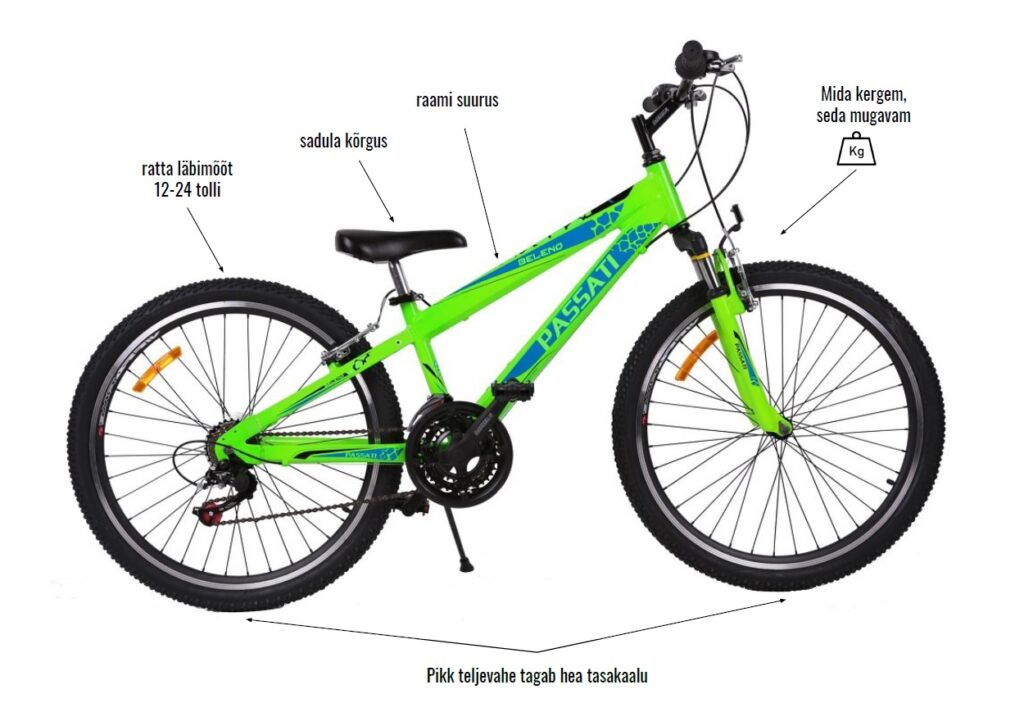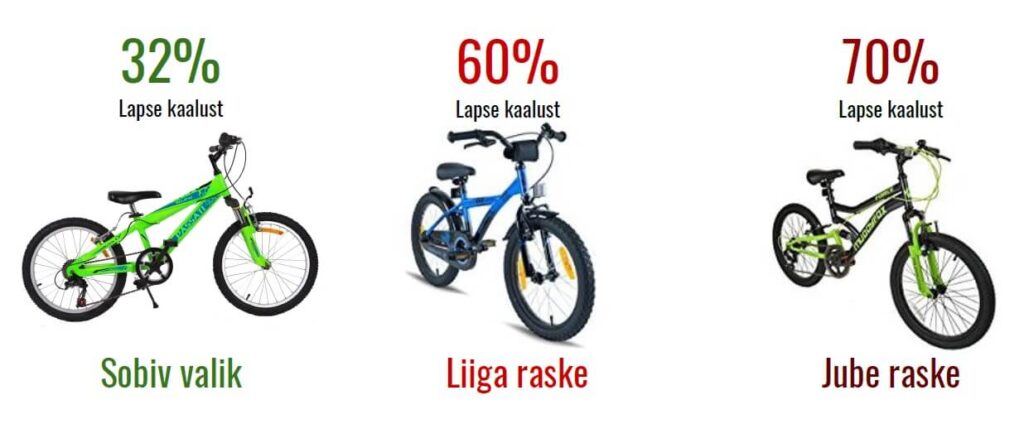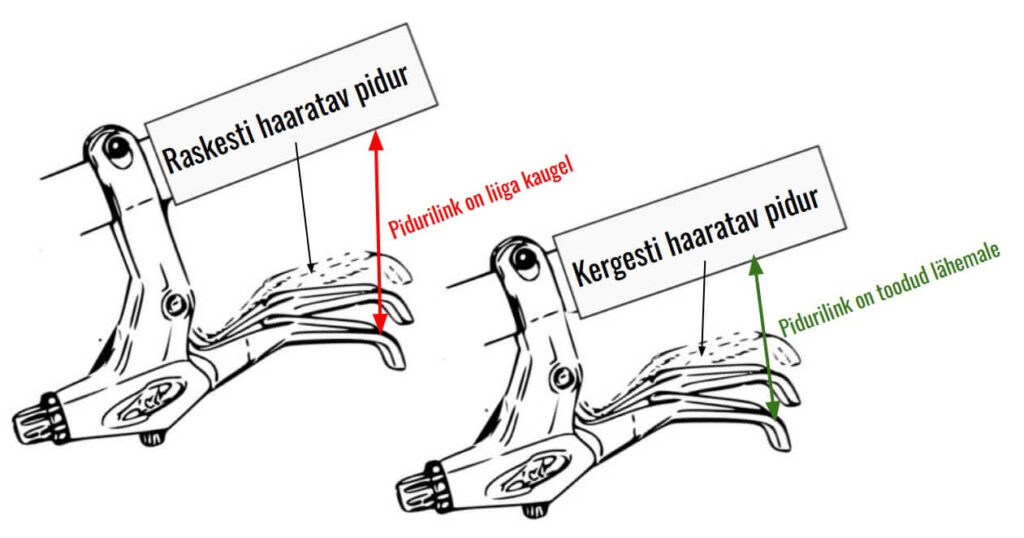Contact
Tööstuse 43, Tallinn, Estonia
Store: +372 508 3309
Workshop: +372 5301 8568
Tähesaju tee 31, Tallinn Estonia
Store: +372 5885 7752
Workshop: +372 5301 6938
Info: +372 508 3309

Choosing a bike for your child is actually easy. You just need to keep an eye on a few important things and know your child! When it comes to truck wheels, it is important to pay particular attention to the different wheel and frame sizes, as well as the shape of the frame. Why the shape of the frame? Because, depending on your child’s growth and riding habits, bikes with different frames can feel very different when ridden. So – when buying a bike for your child, you should definitely keep the following main parameters in mind to help you make the right choice: bike size, weight, frame type, brakes, child’s riding ability and cycling habits. And finally, of course, the price of the bike!
Choosing the right size is a key feature when making your choice. A bike that is too big or too small will make learning to ride difficult and uncomfortable for your child. And of course we don’t want that, because it’s fun to ride a bike! Children’s bikes are divided by wheel/wheel diameter into the following most common sizes: 12, 16, 20, 24 and 26 inches (1 inch = 2.54 cm).
In addition, the height of the bicycle frame must be observed, which also allows the saddle height to be adjusted.

While the size of the wheel plays an important role in the choice, it is also important to consider the minimum height of the saddle. Childrens bikes of the same size may differ in saddle height adjustment. The height of the saddle should be chosen so that the child’s feet are free to touch the ground or at least 1-2 cm from the ground. This makes it possible to stop the ride at any moment if you are leaning, especially if you are not quite sure how to keep your balance. For a child who is familiar with the ride and the brakes, the saddle height can be set so that the toes touch the ground. Otherwise the transmission to the pedals will be uneven.
When choosing the right height of bike frame, make sure that when standing with the frame between your legs, there should be a gap of 2-5 cm between the frame and the child. This will help to prevent accidents if the child slips forward out of the saddle during a fall. Children’s bicycles often have a downward-sloping frame section because of this.
While the average adult’s bike accounts for around 20% of their own weight, children’s bikes often account for as much as 50%. Ideally, the wheel should make up less than 40% of the child’s weight, but very often this is not possible. When buying a bicycle, you should choose one that is as light as possible, as it will be easier for your child to ride. However, it is difficult to find the lightest possible bike for a toddler, as the weight difference between aluminium-framed and steel-framed bikes is only a couple of kilos. However, the price difference between these materials is sometimes quite decent. So, as the weight difference is not that big, the rule of thumb for child bikes is that if the rider likes the bike, it’s in good condition, manoeuvrable and easy to handle, and it’s just the right size, the weight doesn’t matter. The main thing is that the child rides and enjoys it!

When considering the shape of the wheel frame, it is important to keep the axle spacing in mind. The smaller the axle spacing, the more difficult it is to keep the wheel balanced. A wheel with a larger wheelbase provides better stability and also allows better control of the wheel. Be sure to check the space between the child and the handlebars: the closer the handlebars, the more difficult it is to manoeuvre the bike. It can also cause your knees to knock off during cranking. In addition to the spacing of the lenses, their position must also be observed. Forward-facing lenses provide better balance when leaning, while lenses that are too high will affect manoeuvrability and balance. However, low-slung leashes may not be suitable for everyone; for a child who is just learning to ride, they can cause muscular tension in the neck area. Therefore, a wheel with a medium lens height is the best choice, ensuring a comfortable body position and handling. Fortunately, most children’s bikes are also height-adjustable and can change the angle of the lens – closer or further away from the rider.
| Wheel size | Suitable age | Child’s height |
| 12 inches | 2-4 | 80-105 cm |
| 16 inches | 4-6 | 100-115cm |
| 20 inches | 6-9 | 110-135cm |
| 24 inches | 8-12 | 130-150cm |
| 26 inches | 10+ | 140cm+ |
Brakes! People often ask whether foot brakes or hand brakes are better. Usually, for very small children’s bikes, the rear brake is the foot brake and the first one is always the hand brake. But there are also wheels with both handbrakes. Which is better? With truck brakes in mind, foot brakes can be a big headache when learning to ride. Children unconsciously start to crank the pedals backwards to maintain balance. When kneed in this way, the footrests will cause you to fall or stop. And when the child moves to a bigger bike with both rear and front brakes that can be braked with the handlebars, it will take some time to relearn.

When using handbrakes, care must be taken to ensure that they are not too far from the handlebars or lens. Otherwise, it will be difficult for the child to reach them and braking will require a lot of effort, which could become dangerous. However, by changing the angle of the brakes, you can make them easier for your child’s small hands to grip. To do this, simply release the brake slightly from the lens using a hex key and twist it slightly until you have the best braking position!
At high speed or when driving downhill, suddenly using the front brake can catch you flying over the lens. But let’s be honest – it’s not often that a child reaches this speed! However, it is important to make it clear to the child from the outset that braking should be done with both hands at the same time, or using only the rear brake.
Wheels smaller than 20 inches usually have only one gear. Why? The answer is simple. First of all, gears aren’t really necessary for toddlers – more energy should be spent on the fun of driving, not cranking the gears (out of place :)). In addition, children’s bicycles up to 16″ are often equipped with training wheels to help your baby learn to ride safely. However, it is difficult to fit training wheels on a geared bike. The gearshift is just in front of the training wheels. Of course, this is possible with special solutions and a little engineering, but does it make sense? Sure – a gearbox can make cycling more efficient and faster, but it still takes a bit of practice and experience. Let’s take the development of a toddler as an example. Nobody starts running straight away – at first you crawl, then you shuffle, and only then come the steps and the jog. And cycling!
In short, it’s a good idea to start learning to cycle with the right bike. Choose the lightest, widest wheelbase bike possible to help your child learn to ride. The presence of hand brakes and the lack of gear shifting also make it easier. If the rider is more experienced, the bike may have more “bells and whistles”.
The main thing is that the child is happy and moving with joy!